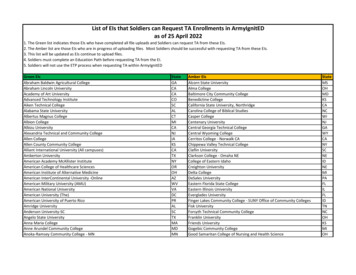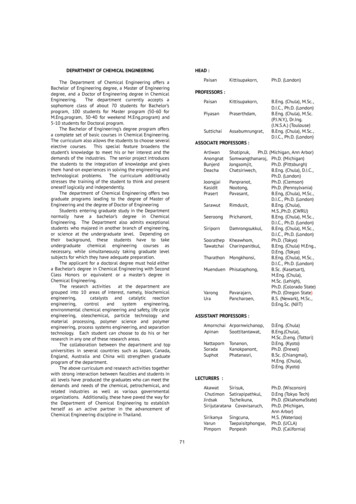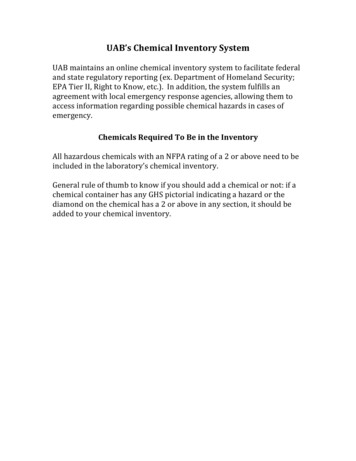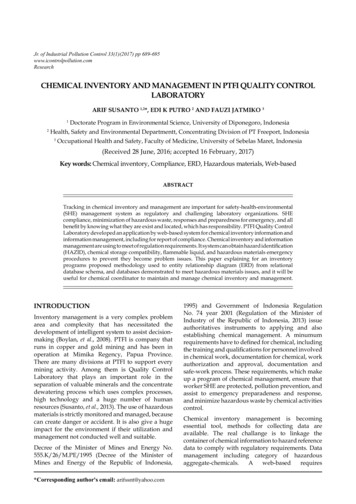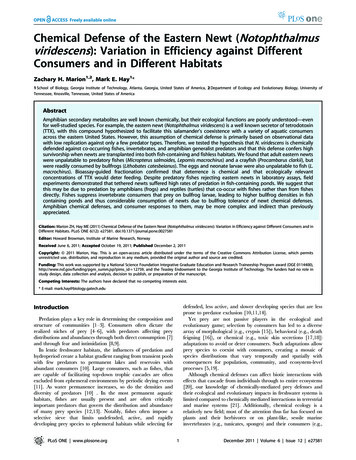
Transcription
Chemical Defense of the Eastern Newt (Notophthalmusviridescens): Variation in Efficiency against DifferentConsumers and in Different HabitatsZachary H. Marion1,2, Mark E. Hay1*1 School of Biology, Georgia Institute of Technology, Atlanta, Georgia, United States of America, 2 Department of Ecology and Evolutionary Biology, University ofTennessee, Knoxville, Tennessee, United States of AmericaAbstractAmphibian secondary metabolites are well known chemically, but their ecological functions are poorly understood—evenfor well-studied species. For example, the eastern newt (Notophthalmus viridescens) is a well known secretor of tetrodotoxin(TTX), with this compound hypothesized to facilitate this salamander’s coexistence with a variety of aquatic consumersacross the eastern United States. However, this assumption of chemical defense is primarily based on observational datawith low replication against only a few predator types. Therefore, we tested the hypothesis that N. viridescens is chemicallydefended against co-occurring fishes, invertebrates, and amphibian generalist predators and that this defense confers highsurvivorship when newts are transplanted into both fish-containing and fishless habitats. We found that adult eastern newtswere unpalatable to predatory fishes (Micropterus salmoides, Lepomis macrochirus) and a crayfish (Procambarus clarkii), butwere readily consumed by bullfrogs (Lithobates catesbeianus). The eggs and neonate larvae were also unpalatable to fish (L.macrochirus). Bioassay-guided fractionation confirmed that deterrence is chemical and that ecologically relevantconcentrations of TTX would deter feeding. Despite predatory fishes rejecting eastern newts in laboratory assays, fieldexperiments demonstrated that tethered newts suffered high rates of predation in fish-containing ponds. We suggest thatthis may be due to predation by amphibians (frogs) and reptiles (turtles) that co-occur with fishes rather than from fishesdirectly. Fishes suppress invertebrate consumers that prey on bullfrog larvae, leading to higher bullfrog densities in fishcontaining ponds and thus considerable consumption of newts due to bullfrog tolerance of newt chemical defenses.Amphibian chemical defenses, and consumer responses to them, may be more complex and indirect than previouslyappreciated.Citation: Marion ZH, Hay ME (2011) Chemical Defense of the Eastern Newt (Notophthalmus viridescens): Variation in Efficiency against Different Consumers and inDifferent Habitats. PLoS ONE 6(12): e27581. doi:10.1371/journal.pone.0027581Editor: Howard Browman, Institute of Marine Research, NorwayReceived June 6, 2011; Accepted October 19, 2011; Published December 2, 2011Copyright: ß 2011 Marion, Hay. This is an open-access article distributed under the terms of the Creative Commons Attribution License, which permitsunrestricted use, distribution, and reproduction in any medium, provided the original author and source are credited.Funding: This work was supported by a National Science Foundation Integrative Graduate Education and Research Traineeship Program award (DGE 0114400),http://www.nsf.gov/funding/pgm summ.jsp?pims id 12759, and the Teasley Endowment to the Georgia Institute of Technology. The funders had no role instudy design, data collection and analysis, decision to publish, or preparation of the manuscript.Competing Interests: The authors have declared that no competing interests exist.* E-mail: mark.hay@biology.gatech.edudefended, less active, and slower developing species that are lessprone to predator exclusion [10,11,14].Yet prey are not passive players in the ecological andevolutionary game; selection by consumers has led to a diversearray of morphological (e.g., crypsis [15]), behavioral (e.g., deathfeigning [16]), or chemical (e.g., toxic skin secretions [17,18])adaptations to avoid or deter consumers. Such adaptations allowprey species to coexist with consumers, creating a mosaic ofspecies distributions that vary temporally and spatially withconsequences for population, community, and ecosystem-levelprocesses [5,19].Although chemical defenses can affect biotic interactions witheffects that cascade from individuals through to entire ecosystems[20], our knowledge of chemically-mediated prey defenses andtheir ecological and evolutionary impacts in freshwater systems islimited compared to chemically mediated interactions in terrestrialand marine systems [21]. Additionally, chemical ecology is arelatively new field; most of the attention thus far has focused onplants and their herbivores or on plant-like, sessile marineinvertebrates (e.g., tunicates, sponges) and their consumers (e.g.,IntroductionPredation plays a key role in determining the composition andstructure of communities [1–3]. Consumers often dictate therealized niches of prey [4–6], with predators affecting preydistributions and abundances through both direct consumption [7]and through fear and intimidation [8,9].In lentic freshwater habitats, the influences of predation andhydroperiod create a habitat gradient ranging from transient poolswith few predators to permanent lakes and reservoirs withabundant consumers [10]. Large consumers, such as fishes, thatare capable of facilitating top-down trophic cascades are oftenexcluded from ephemeral environments by periodic drying events[11]. As water permanence increases, so do the densities anddiversity of predators [10] . In the most permanent aquatichabitats, fishes are usually present and are often criticallyimportant predators that govern the distribution and abundanceof many prey species [12,13]. Notably, fishes often impose aselective sieve that limits undefended, active, and rapidlydeveloping prey species to ephemeral habitats while selecting forPLoS ONE www.plosone.org1December 2011 Volume 6 Issue 12 e27581
Chemical Defense of the Eastern Newtpermit #A08047. Collections were under the auspices of NationalPark Service Permit #48516 and Georgia Department of NaturalResources permit #29-WBH-08-185. Permissions to work onprivate lands were obtained verbally from each land owner.The eastern newt (Notophthalmus viridescens Rafinesque, Salamandridae) is one of the most widely distributed salamanders in NorthAmerica [45] and occupies lentic environments across thespectrum from temporary to permanent water bodies. Shallowwetlands (#1 m) with aquatic vegetation (e.g., Chara, Utriculariaspp.) are ideal habitats, but large population densities (ca. 5 adults/m) can also occur in lakes, beaver impoundments, vernal pools,ponds and roadside ditches [45,46].Notophthalmus viridescens secrete tetrodotoxin (TTX) [27,34],which could serve as a chemical defense against predators.Pharmacologically, the mechanism behind TTX toxicity is welldescribed [47]; it is a neurotoxin that blocks nerve and muscleconductance through selective inhibition of sodium channels[47,48]. Concentrations of TTX are greatest in the red eft stage,followed by adults, eggs, and finally larvae [27,49,50]. There arenatural history and observational reports of newts being distastefulor toxic to predators (e.g., [35,36,51]), but statistically rigorousevaluation of this for N. viridescens are not available, as is the casefor a surprising number of amphibians [52].Adult Notophthalmus viridescens were collected by seine or dipnetfrom Georgia ponds in Walker, Rabun, and Athens-Clarkecounties (Georgia Department of Natural Resources permit#29-WBH-08-185, with additional verbal permissions from eachland owner). Newts were housed in aquaria with dechlorinated tapwater at the Georgia Institute of Technology and fed fish pellets(African Cichlid Attack, HBH Pet Products, Springville, UT,USA) and live mealworms (Tenebrio molitor). Oviposition wasencouraged by providing pieces of the aquatic macrophyteMyriophyllum aquaticum as a substrate. Eggs were maintainedindividually in 12612610 cm plastic containers holding dechlorinated tap water (6 cm depth) that was changed biweekly. Afterhatching, neonate larvae were fed freeze-dried copepods (Cyclopeeze, Argent Chemical Laboratories, Redmond, WA, USA) threetimes a week.To assess newt palatability to co-occurring consumers, we usedadult largemouth bass (Micropterus salmoides; 15–20 cm standardlength [SL]), juvenile bluegill sunfish (Lepomis macrochirus; 2–4 cmSL), the crayfish Procambarus clarkii (9–12 cm total length), andadult bullfrogs (Lithobates catesbeianus; 12.5–18 cm snout-ventlength). Largemouth bass consume amphibians across all lifehistory stages [12,53] and were collected from the ChattahoocheeNational Recreation Area (Atlanta, GA, USA; National ParkService Permit #48516). Bluegill are generalist consumers that canheavily impact amphibian communities [14,54]. Our young-ofyear bluegill were acquired from the Walton Fish Hatchery (GADept. of Natural Resources (DNR), Walton County, GA). Weused juveniles because they require less food to obtain anobservable response, thus minimizing the amount of newt assaymaterials required. Crayfish are generalist consumers that candramatically alter the structure of freshwater amphibian communities through both predation and aggression [55–57]. They arenot gape-limited and can prey on large adult salamanders as wellas eggs and larvae. Adult crayfish were collected from the ClaytonCounty Water Authority’s experimental wetlands (GA). Bullfrogsconsume insects, snakes, small mammals, fish, and otheramphibians [58,59]; ours were purchased from Niles BiologicalSupply, Inc. (Sacramento, California, USA). Bass and bullfrogswere individually housed in 76 L aquaria and maintained on a dietof earthworms (Lumbricus terrestris) or crickets (Acheta domesticus),respectively. Bluegill were housed in 38 L aquaria and maintained[20,22]). Chemical defenses among mobile species occupyinghigher trophic levels have received less consideration [23,24].Among vertebrates, amphibians are the most notable anddiverse taxonomic group using putative chemical defenses [17].Many amphibians secrete a pharmacopoeia of noxious compounds (e.g., alkaloids, amines, peptides, steroids) with a variety ofphysiological effects (see [17,25,26] for reviews). Dramaticexamples of toxic amphibians include the rough-skinned newt(Taricha granulosa), a salamander species capable of harboringenough tetrodotoxin (TTX) per individual to kill 25,000 mice ifthe compound is injected [27,28]; this newt serves as the model tothe Batesian mimic Ensatina eschscoltzii xanthoptica [29]. The skin ofPhyllobates terribilis, the golden dart frog, contains up to 1.9 mg ofthe cardiotoxic and neurotoxic batrachotoxin, one of the mostpoisonous natural compounds known [30]. Still, both T. granulosaand P. terribilis are readily consumed by a few well-adaptedpredators [30,31]. However, despite the plethora of informationabout the pharmacology of amphibian natural products[17,25,32], rigorous demonstrations of the ecological functions ofthese metabolites are generally limited to anecdotal andobservational accounts of prey distastefulness and predatorresistance.Like Taricha newts, the eastern newt (Notophthalmus viridescens) isassumed to deter predators by secreting TTX [27,33,34], with alllife-history stages reportedly unpalatable to a variety of vertebrateand invertebrate predators [35,36]. Despite the number of studiesinvolving eastern newt defenses, the majority of the work hasconsisted of observational and anecdotal accounts that lackedproper statistical controls and sufficient replication [35,36]. Earlierstudies also often used consumer of questionable ecologicalrelevance (e.g., farm chickens [37]). .Several studies of chemicaldefenses in N. viridescens used intraperitoneal injections of newtskin, ova, or purified toxin [38], often to the exclusion of predationbioassays with live prey (but see [29,39,40] for bioassays with adifferent newt species). Unfortunately, injections remove the effectsof predator choice and physiological (e.g., salivary proline-richproteins or cytochrome p450 enzymes) and/or behavioraldetoxification methods (e.g., selective feeding on undefendedtissues) that might occur during prey handling or digestion [41].The lack of rigorous research on the chemically-mediatedpredator-prey interactions involving Notophthalmus viridescens issurprising given that eastern newts are thought of as keystonepredators that regulate the diversity and abundance of larvalanurans, aquatic invertebrates, and the ecosystem functions of somefreshwater environments [42–44]. Therefore, we designed a series ofexperiments testing the hypothesis that N. viridescens are unpalatableto ecologically relevant generalist predators because of noxious skinsecretions. Using laboratory-based feeding assays, we offered adultnewts to predatory fishes (Micropterus salmoides, Lepomis macrochirus),crayfish (Procambarus clarkii), and bullfrogs (Lithobates catesbeianus).These were followed by assays evaluating the palatability of differentnewt tissues and different life-history stages (i.e., eggs, larvae, adults).Bioassay-guided fractionation was used to test the hypothesis thateastern newt defenses are chemically based. After determining thatfishes largely avoided newts, we tethered adult newts in ponds withand without predatory fish to test the hypothesis that the risk ofpredation for amphibians—even chemically-defended species—ishigher in permanent ponds containing fishes [10].Materials and MethodsEthics StatementAll procedures were approved by the Institutional Animal Careand Use Committee at the Georgia Institute of Technology underPLoS ONE www.plosone.org2December 2011 Volume 6 Issue 12 e27581
Chemical Defense of the Eastern Newtof the three treatment tissues. If the treatment food was rejected,the fish was offered a second control pellet to ensure the rejectionresponse was not due to satiation. Separate fish were used for eachbody part assay to assure independence among consumers (dorsalskin: n 15, ventral skin: n 17, viscera: n 16). The frequencyof acceptance for each treatment relative to the first control pelletwas analyzed separately for each tissue type with a McNemar test.The relative palatability across newt tissue treatments was thenanalyzed using a likelihood-ratio test from a generalized linearmodel assuming binomial errors using the car package [63], v. 2.0–9. We conducted post-hoc pairwise comparisons with multipleFisher’s exact tests followed by Holm’s sequential Bonferronicorrection.In a final assay with bullfrogs, an adult newt and a Procambarusclarkii crayfish (as a palatable alternative) were simultaneouslyoffered to seven individually housed frogs. We used crayfish asalternative prey because we were unable to obtain appropriatelysized Ambystoma talpoideum when this experiment was conducted.Before the assay, each frog received three crickets to ensure theirresponses were not starvation-induced. After prey were exposed tofrogs for 24 h, each tank was thoroughly inspected for uneatenindividuals and a one-tailed exact McNemar test was used to assessdifferences in survival between the two prey.The above assays determined that newts were distasteful tofishes and crayfish, so we decided to also test the palatability ofother life stages of Notophthalmus viridescens because it has beenhypothesized that juvenile stages that must under-go dramaticdevelopmental shifts cannot be chemically defended like adults[64], but this is not the case for marine species [65]. Because wewere limited by the number of newt ontogeny available, we onlyused bluegill as assay predators, in part because juvenile fish wereoften found in vegetation occupied by newt embryos and larvae;crayfishes never were (Z.M., personal observation). Bluegill (n 10) were offered eggs of N. viridescens along with a control foodpellet (African Cichlid Attack, HBH Pet Products, Springville, UT,USA) in a paired-choice feeding assay identical to the bluegillbioassay with adult newt tissues. Bluegill were first offered a foodpellet followed by a newt egg. If the egg was rejected, a secondcontrol pellet was offered to assess whether that fish was satiated.We considered an egg rejected if the fish struck the egg, spit it out,and then ignored it.To determine whether newt hatchlings were distasteful to fish,we offered bluegill a neonate newt larva and an Ambystomamaculatum hatchling in a paired-choice assay (n 13). Werandomized the order of treatment that each fish received. Spottedsalamander neonates are slightly larger on average than N.viridescens hatchlings (12–17 mm and 7–9 mm respectively; [45]),but juvenile bluegill showed no size-based attack preference andpursued both larval species equally. Because the salamanders didnot hatch simultaneously, the bioassay was staggered over twodays, ensuring that no larva was over 1 d old. No bluegillindividual was used more than once. Tests with both eggs andhatchlings were evaluated via one-tailed exact McNemar tests.Because adult Notophthalmus viridescens were consistently rejectedby bass and crayfish, we evaluated whether rejections were (1) dueto chemical deterrents, and (2) might be explained by the presenceof TTX with bioassay-guided fractionation. To obtain newt crudechemical extracts we euthanized and eviscerated 10 adult newts,macerated non-viscera tissues in a blender with methanol andwater (7:3 v:v), let this extract overnight, then successivelyextracted for two hours in methanol and dichloromethane (1:0v:v, 1:1 v:v, and 0:1 v:v). Solvents were subsequently removed byrotary evaporation and the extract was then resuspended inmethanol for bioassays. We gutted the newts because chemicalon a diet of fish pellets (African Cichlid Attack, HBH Pet Products,Springville, UT, USA), while crayfish were housed individually in12612610 cm plastic containers within a recirculating freshwatertable and fed herbivorous fish food.For assays assessing palatability of adult animals, we used molesalamanders (Ambystoma talpoideum) as palatable alternative preybecause they often co-occur with eastern newts and are equivalentin swimming ability and size [45]. All A. talpoideum were collectedfrom the University of Georgia’s Whitehall Forest. For assaysassessing palatability of larval newts, we used larval spottedsalamanders (Ambystoma maculatum) as alternative prey because theyfrequently share fishless ponds with both larval and adult easternnewts [45]. To obtain A. maculatum larvae, we collected two eggmasses from a spring-fed pool in Palmetto, GA, maintained eggs inthe laboratory until they hatched, and raised the larvae on freezedried copepods until they were used in experiments.Laboratory feeding assaysWe offered consumers newts or similar control foods todetermine the relative palatability of newts to consumers. Wesimultaneously offered an adult newt and a paedomorphicAmbystoma talpoideum to 11 largemouth bass, each housed in aseparate aquarium. Prior to the assay, bass were fed one largeearthworm to ensure feeding choices did not reflect starvation.The bioassay was initially conducted for 14 h (i.e., overnight,because largemouth bass are crepuscular feeders [53,60]). After14 h, each replicate tank was thoroughly inspected and thepresence or absence of each salamander was noted. We thenextended the bioassay for a total of 72 h to observe whetherhunger would overwhelm any initial distastefulness; however,results at 14 h and 72 h did not differ. We used a one-tailed exactMcNemar test for paired samples (exact262 package [61], v. 1.1)to assess differences in survivorship between the two salamanderspecies with the a priori hypothesis that N. viridescens would be lesspalatable than the Ambystoma alternative. All statistical analyseswere performed in R [62], v. 2.121.For assays with crayfish, consumers were acclimated for 48 h inglass aquaria (51627 cm) with 6 cm of water depth. Immediatelyprior to the bioassay, 10 newts and 10 A. talpoideum wereeuthanized by immersion in a 250 mg/L solution of MS-222(tricane methylsulfonate) for 10 min followed by several rinses withdeionized water. This minimized prey suffering and removed anydifferential escape behaviors, allowing a test of palatability alone.It is possible that MS-222 alters prey palatability, but unlikelygiven the compound’s high solubility in water. Our subsequentand extensive rinses following death should have removed thecompound, and a pilot study revealed no detectable affects oncrayfish feeding. We simultaneously offered crayfish one newt andone A. talpoideum; after 18 h, both prey choices were removed andfrequency of consumption assessed with a one-tailed exactMcNemar test.If toxin production in newts serves primarily as a defense againstpredation (instead of against microbes or other pests), then onemight expect defenses to be preferentially allocated to body partsthat are most exposed to consumers (i.e., dorsal skin). Young-ofyear bluegill were used for assessing the palatability of differingnewt body tissues. Six adult newts were euthanized, carefullyskinned to keep the dorsal and ventral skin separate, and theinternal organs then removed. The newt tissues (dorsal skin,ventral skin, and viscera) were cut into small pieces approximately5 mm and each tissue type pooled for the bioassay. Individualbluegill were first offered a control food pellet (African CichlidAttack, HBH Pet Products, Springville, UT, USA) to assure theywere feeding. If the pellet was eaten, that fish was then offered onePLoS ONE www.plosone.org3December 2011 Volume 6 Issue 12 e27581
Chemical Defense of the Eastern Newtand day as fixed factors and fish ID as a random factor thenevaluated significance with likelihood ratio tests.defenses occur primarily in the skin [26] and because our previouspredation assays indicated a rapid rejection that suggestedmetabolites are presented on newt exteriors.To prepare test foods the extract was incorporated into a gelbased artificial food constructed with freeze-dried and finelyground frog legs, sodium alginate (27% by dry mass; SigmaAldrich, St. Louis, MO, USA) and 25 mg of red food coloring forvisibility. The method for control foods was identical, including thesolvent, but lacked the newt extract. Extracts were tested at doubletheir yield (by volumetric equivalent) to offset loss due to extractioninefficiencies and chemical decomposition (see [66] for an exampleof such losses). This gel was loaded into a small syringe, squeezedinto lines on a glass petri dish, and misted with a hardeningsolution of 0.25 M calcium chloride. After ca. 1 min, the gel wascut into bite-sized pellets. This method resulted in frog ‘‘noodles’’with the consistency of cooked pasta (for an overview, see [67]).These treatment foods vs. identical control foods (but without thenewt extract) were then offered to juvenile bluegill. Followingconfirmation of deterrent activity, the remaining crude extract waspartitioned between ethyl acetate (lipids) and distilled water (thepolar fraction), and fractions were tested separately for deterrentactivity using the methods described above except that the polarfraction was resuspended in distilled water.For the feeding assays, juvenile bluegill were held individually in38 L aquaria divided across the middle with mesh so that eachaquarium held two bluegill (one on each side). Prior to the bioassay,each fish was fed two food pellets to ensure feeding responses werenot starvation-induced. In the afternoon each individual fish—assigned to treatments at random and interspersed spatially—received either a pellet containing newt extract or a control pelletand were monitored for acceptance or rejection of the treatment.No fish was used more than once. We determined statisticaldifferences between experimental extract treatments and controltreatments with a one-tailed Fisher’s exact test.Field predation experimentWe quantified the relative risk of predation for eastern newts infield habitats with and without fish by tethering adult Notophthalmusviridescens in paired, permanent ponds (n 6 pairs of ponds; 9–12newts per pond) for 18 h in September of 2009—for each pair ofponds, one pond contained predatory fish (e.g., largemouth bass,bluegill) while the other pond lacked fish. We used permanentponds because (1) N. viridescens often reach their greatestabundances in permanent fishless ponds [45], (2) to minimizeany differences associated with the abiotic impact of drying (e.g.,salinity, conductance, dissolved oxygen), and (3) the southeasternUS was recovering from the effects of a severe drought and therewere few ephemeral ponds still holding water at this time. Pondswithin a pair were located no more than 2 km apart, making theexperiment tractable and minimizing variance due to location. Allponds were drag-seined and dipnetted to identify the fish speciespresent. Additionally, many fish-containing ponds were stocked forpublic fishing by the Georgia DNR so species presence could beverified with DNR catalogs of fish presence.Newts were tethered by fastening a nylon cable tie(10062.39 mm) around the torso just anterior of the pelvic girdlePrior to securing the cable tie, we fastened approximately 3 m ofclear 3.63 kg test monofilament fishing line through the tie’sratchet case. The cable tie was tightened until the newt could notslip out but was left loose enough for the animal to rotate freelyand allow unconstrained movement. The remaining length ofcable tie was then cut flush with the ratchet case. We secured thefishing line to the pond bank with a 23 cm metal stake driven intothe pond bank. The newt was then placed at the water’s edge andallowed to enter on its own.Newts were spaced 6 m apart and their presence or absencewas monitored every two hours. We recorded newt presence,survival, and injuries from failed predation attempts. Potentialpredators near each individual were also noted (e.g., ranid frogs,turtles, predacious invertebrates). Because individual newts withinponds may not be independent, we calculated the final percentsurvival for each pond at the end of the 18 h exposure andanalyzed the data with a paired t-test, using each pond pair as thelevel of replication.Predator avoidance conditioningWe wanted to evaluate how quickly naı̈ve fish would learn toavoid food containing a range of TTX concentrations commonlyfound in eastern newts. Whole animal concentrations of TTXreported for Notophthalmus viridescens range from ,0.15 to 146 mg/gof wet mass [34,49]. Therefore, over 6 d, we exposed naı̈ve bluegillto artificial foods reconstituted with one of five TTX concentrations: 0, 10, 20, 40, and 80 mg/g of TTX (n 20/treatment). Thehighest concentration we used (80 mg/g TTX) was only 55% ofthe highest concentration reported for N. viridescens in the wild. Foreach TTX treatment, tetrodotoxin citrate (Ascent Scientific,Princeton, NJ, USA) was reconstituted into a gel-based artificialdiet after resuspension in distilled water using the methodsdescribed above. The control pellets were constructed identicallybut lacked TTX.Prior to the experiment, juvenile bluegill were acclimated individed aquaria (one fish per side). Each morning they receivedtwo food pellets to ensure feeding responses were not starvationinduced. In the afternoon an individual received one of the fivetreatments mentioned above. Fish were assigned to treatments byrandom interspersion. Over 6 d, we monitored whether fish atethe offered pellet or rejected it. One fish in the 10 mg/g treatmentand two fish in the 80 mg/g treatment refused to feed throughoutthe experiment and were excluded from the analysis. The datawere analyzed with a generalized linear mixed model (GLMM) fitby Gaussian Hermite approximation (nAGQ 15) andbinomially distributed errors using the lme4 package [68], v.0.999375-37. We started with a saturated model and used Akaike’sInformation Criterion [69] to remove all parameters but treatmentPLoS ONE www.plosone.orgResultsNewts were unpalatable to both largemouth bass (Figure 1A;P 0.002) and the generalist crayfish Procambarus clarkii, relative toAmbystoma talpoideum (Figure 1B; P 0.004). Both predatorsshowed a 9–10X preference for Ambystoma over N. viridescens; i.e.,nine and 10 Ambystoma were consumed for every newt by crayfishand bass, respectively. Bass took newts into their buccal cavity andimmediately spit them out, followed by coughing and rapidoperculation. A few bass repeatedly attacked the newts, but newtswere rejected each time and no newts were killed, even whenrepeatedly attacked. Two newts had abrasions that suggested theyhad been chewed in the pharyngeal jaws before rejection; theinjuries were not fatal. In contrast, no bass ever rejected an A.talpoideum salamander. The single newt consumed by a crayfish waseviscerated: its internal organs and much of the inner meat wasconsumed, but the dorsal skin was intact and unconsumed. Severalother newts were missing toes and tail tips, suggesting they hadbeen captured, sampled, and rejected. All but one of the A.talpoideum were almost completely consumed by the crayfish. Onlythe skull and spinal cord remained for nine out of 10 individuals.4December 2011 Volume 6 Issue 12 e27581
Chemical Defense of the Eastern NewtWe used small bluegill to assess the palatability of different skin orbody portions of newts. When compared to a palatable control food(100% consumed), newt viscera (75% consumed) were mildlydeterrent (P 0.031), dorsal skin portions (20% consumed) werestrongly rejected, while ventral skin (35% consumed) was rejected atan intermediate frequency (Figure 2; P # 0.003). Newt tissues differedsignificantly from each other in palatability (GLM: P 0.016, df 2,46), with dorsal skin being less palatable than viscera (Holm’scorrected Fisher’s exact test: P 0.011) and ventral skin beingintermediate between these tissues (Figure 2).Eggs of Notophthalmus viridescens were also unpalatable to bluegill;they accepted only three of 10 eggs offered, but consumed all 10 ofthe paired control foods (Figure 3a; P 0.008). All f
array of morphological (e.g., crypsis [15]), behavioral (e.g., death feigning [16]), or chemical (e.g., toxic skin secretions [17,18]) adaptations to avoid or deter consumers. Such adaptations allow prey species to coexist with consumers, creating a mosaic of species distributions that vary temporally and spatially with


